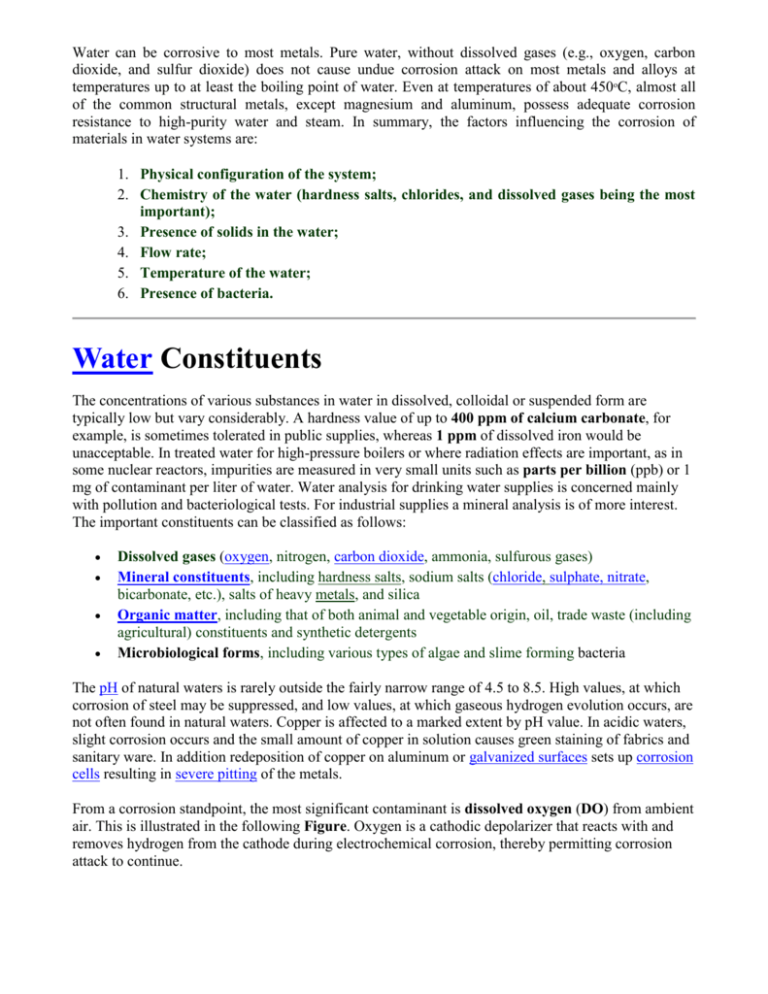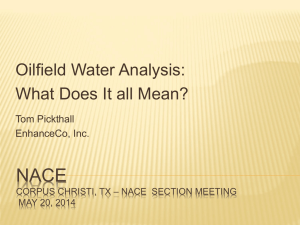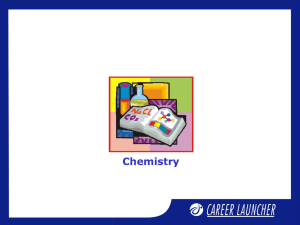Water can be corrosive to most metals
advertisement

Water can be corrosive to most metals. Pure water, without dissolved gases (e.g., oxygen, carbon dioxide, and sulfur dioxide) does not cause undue corrosion attack on most metals and alloys at temperatures up to at least the boiling point of water. Even at temperatures of about 450oC, almost all of the common structural metals, except magnesium and aluminum, possess adequate corrosion resistance to high-purity water and steam. In summary, the factors influencing the corrosion of materials in water systems are: 1. Physical configuration of the system; 2. Chemistry of the water (hardness salts, chlorides, and dissolved gases being the most important); 3. Presence of solids in the water; 4. Flow rate; 5. Temperature of the water; 6. Presence of bacteria. Water Constituents The concentrations of various substances in water in dissolved, colloidal or suspended form are typically low but vary considerably. A hardness value of up to 400 ppm of calcium carbonate, for example, is sometimes tolerated in public supplies, whereas 1 ppm of dissolved iron would be unacceptable. In treated water for high-pressure boilers or where radiation effects are important, as in some nuclear reactors, impurities are measured in very small units such as parts per billion (ppb) or 1 mg of contaminant per liter of water. Water analysis for drinking water supplies is concerned mainly with pollution and bacteriological tests. For industrial supplies a mineral analysis is of more interest. The important constituents can be classified as follows: Dissolved gases (oxygen, nitrogen, carbon dioxide, ammonia, sulfurous gases) Mineral constituents, including hardness salts, sodium salts (chloride, sulphate, nitrate, bicarbonate, etc.), salts of heavy metals, and silica Organic matter, including that of both animal and vegetable origin, oil, trade waste (including agricultural) constituents and synthetic detergents Microbiological forms, including various types of algae and slime forming bacteria The pH of natural waters is rarely outside the fairly narrow range of 4.5 to 8.5. High values, at which corrosion of steel may be suppressed, and low values, at which gaseous hydrogen evolution occurs, are not often found in natural waters. Copper is affected to a marked extent by pH value. In acidic waters, slight corrosion occurs and the small amount of copper in solution causes green staining of fabrics and sanitary ware. In addition redeposition of copper on aluminum or galvanized surfaces sets up corrosion cells resulting in severe pitting of the metals. From a corrosion standpoint, the most significant contaminant is dissolved oxygen (DO) from ambient air. This is illustrated in the following Figure. Oxygen is a cathodic depolarizer that reacts with and removes hydrogen from the cathode during electrochemical corrosion, thereby permitting corrosion attack to continue. Effect of oxygen concentration on the corrosion of low-carbon steel in tap water at different temperatures. The effect of oxygen on corrosion with increasing temperature is also shown in the following Figure, indicating the results in a closed versus an open container (the latter permitting natural deaeration by ebullition). In a closed vessel, corrosion continues to increase with temperature, whence the requirement for removing DO from hot water systems and boilers. Effect of oxygen on corrosion of steel. Other constituents that contribute to corrosion are chlorides and carbon dioxide, possibly calcium, as will be explained later, and sulfides or ammonia from industrial or natural sources. Of course, many other man-made contaminants can be found in local areas if industries are permitted to discharge their waste products into water resources. As with other chemical reactions, corrosion increases with elevated temperature, unless stifled by insoluble scales, the removal of corrosive gases, or the addition of corrosion inhibitors. The formation of scale on a surface can be positive by providing an excellent protection of the substrate or negative by accentuating pitting at pores, cracks, or other voids in the film. If the film attains any significant thickness, the loss of heat transfer through the metal and deposited scale can also be a problem in certain applications. Thus, the development of scales on metal surfaces is an important consideration when using metals in waters. The effect of oxygen and pH on the corrosion rate of steel at two temperatures is shown in the following Figure. Corrosion of steel in water containing 5 ppm of dissolved oxygen at two different temperatures as a function of the water pH. In a broad range of about pH 5 to 9, the corrosion rate can be expressed simply in terms of the amount of DO present (e.g., µm/y per ml. DO per liter of water). At about pH 4.5, acid corrosion is initiated, overwhelming the oxygen control. At about pH 9.5 and above, deposition of insoluble ferric hydroxide tends to stifle the corrosion attack. Amphoteric metals also show an increase in the corrosion rate in alkaline environments. Aluminum and lead are examples of amphoteric metals. The following Figure shows the behavior of steel and aluminum as a function of pH. Corrosion of steel and aluminum as a function of pH at the same temperature (22oC). Types of Water Water is commonly described either in terms of its nature, usage, or origin. The implications in these descriptions range from being highly specific to so general as to be non-definitive. Ground waters originate in subterranean locations such as wells, while surface waters comprise the lakes, rivers, and seas. Fresh Water Fresh water may come from either a surface or ground source, and typically contains less than 1% sodium chloride. It may be either "hard" or "soft," i.e., either rich in calcium and magnesium salts and thus possibly forming insoluble curds with ordinary soap. Actually, there are gradations of hardness, which can be estimated from the Langelier or Ryznar indexes or accurately determined by titration with standardized chelating agent solutions such as versenates. Brackish Water Brackish water contains between 1 and 2.5% sodium chloride, either from natural sources around otherwise fresh water or by dilution of seawater. Brackish water differs from open seawater in certain other respects. The biological activity, for example, can be significantly modified by higher concentrations of nutrients. Fouling is also likely to be more severe as a consequence of the greater availability of nutrients. Within harbors, bays, and other estuaries, marked differences can exist in the amount and type of fouling agents present in the water. The main environmental factors responsible, singly or in combination, for these differences are the salinity, the degree of pollution, and the prevalence of silt. Moreover, the influence of these factors can be very specific to the type of organism involved. Apart from differences that can develop between different parts of the same estuary, there can also be differences between fouling in enclosed waters and on the open coast. In this respect the extent of offshore coastal fouling is strongly determined by the accessibility to a natural source of infection. Local currents, average temperature, seasonal effects, depth, and penetration of light are operative factors. The presence of pollutants can also be quite important and highly variable in coastal areas. Seawater Seawater typically contains about 3.5% sodium chloride, although the salinity may be weakened in some areas by dilution with fresh water or concentrated by solar evaporation in others. Seawater is normally more corrosive than fresh water because of the higher conductivity and the penetrating power of the chloride ion through surface films on a metal. The rate of corrosion is controlled by the chloride content, oxygen availability, and the temperature. The 3.5% salt content of seawater produces the most corrosive chloride salt solution that can be obtained as shown in the following Figure. Corrosion of steel in various sodium chloride solutions. Note the peak in corrosion rate at approximately 3% salt. The combination of high conductivity and oxygen solubility is at a maximum at this point (oxygen solubility is reduced in more concentrated salt solutions). The corrosion of numerous metals in a wide range of saline waters is reported in the following Table. Effect of velocity on the corrosion of metals in seawater Scaling Indices Encrustation of tubing, boilers, coils, jets, sprinklers, cooling towers, and heat exchangers arise wherever hard water is used. Scale formation can greatly affect heat transfer performance. One mm thick scale, for example, can add 7.5% to energy costs, while 1.5 mm adds 15% and 7 mm can increase cost by over 70%. Many factors can affect scaling. Scaling, which is basically the deposition of mineral solids on the interior surfaces of water lines and containers, most often occurs when water containing the carbonates or bicarbonates of calcium and magnesium is heated. The saturation level (SL) of water in a mineral phase is a good indicator of the potential for scaling due to that specific scalant. SL is a ratio between the ion activity product (IAP) and the thermodynamic solubility product (Ksp) of a specific compound in that water. For example, when calcium carbonate (CaCO3) is the scalant SL is defined as: where is the IAP of the two ions involved in the formation of CaCO3, i.e. Ca2+ and CO32-. Ksp is a measure of ionic concentration when dissolved ions and undissolved ions are in equilibrium. When a saturated solution of sparingly or slightly soluble salt is in contact with undissolved salt, equilibrium is established between the dissolved ions and the undissolved salt. In theory, this equilibrium condition is based upon an undisturbed water maintained at constant temperature and allowed to remain undisturbed for an infinite period of time. In this example, water is said to be undersaturated (SL value less than 1) if it can still dissolve calcium carbonate. When water is at equilibrium, SL will be 1.0 by definition. Supersaturated water (SL value greater than 1) will precipitate calcium carbonate from water if allowed to rest. As the saturation level increases beyond 1.0, the driving force for the precipitation of calcium carbonate increases. The following sections will describe some indices that have gained wide acceptance in the corrosion community. However, it should be stated that these indices are designed to indicate the tendency of given waters to deposit scales on metal substrates and surely not to predict the absolute corrosivity of specific waters. Generally speaking, scales precipitated onto metal surfaces can provide protection of the substrate from general corrosion. If on the other hand the scales are defective and contain voids and/or cracks. they could lead to localized corrosion. The assumption that water below saturation with respect to calcium carbonate is corrosive, while occasionally correct, is not reliable. Langelier Saturation Index (LSI) The LSI is probably the most widely used indicator of cooling water scale potential. This index indicates the driving force for scale formation and growth in terms of pH as a master variable. In order to calculate the LSI, it is necessary to know the alkalinity (mg L-1 as CaCO3 or calcite), the calcium hardness (mg L-1 Ca2+ as CaCO3), the total dissolved solids (mg L-1 TDS), the actual pH, and the temperature of the water (oC). If TDS is unknown, but conductivity is, one can estimate mg L-1 TDS using the following conversion Table. Conversion table between the conductivity of natural water and the total dissolved solids (TDS) it contains. LSI is defined as: Where: pH is the measured water pH pHs is the pH at saturation in calcite or calcium carbonate and is defined as: As for the SL reasoning described earlier, the LSI indicates three situations: If LSI is negative: No potential to scale, the water will dissolve CaCO3 If LSI is positive: Scale can form and CaCO3 precipitation may occur If LSI is close to zero: Borderline scale potential Water quality or changes in temperature, or evaporation could change the index. As an example, suppose the drinking water supplied to animals has the following analysis: pH = 7.5 TDS = 320 mg/L Calcium = 150 mg L-1 (or ppm) as CaCO3 Alkalinity = 34 mg L-1 (or ppm) as CaCO3 The LSI index is calculated at two temperatures, i.e. 25oC (room temperature) and 82oC (cage wash cycle). The colder incoming water will warm to room temperature in the manifolds. Residual water in the rack manifold can be heated to 82oC when the rack is in the cage washer. LSI Formula: LSI = pH - pHs pHs = (9.3 + A + B) - (C + D) where: A = (Log10[TDS] - 1)/10 = 0.15 B = -13.12 x Log10(oC + 273) + 34.55 = 2.09 at 25°C and 1.09 at 82°C C = Log10[Ca2+ as CaCO3] - 0.4 = 1.78 D = Log10[alkalinity as CaCO3] = 1.53 Calculation at 25oC: pHs = (9.3 + 0.15 + 2.09) - (1.78 + 1.53) = 8.2 LSI = 7.5 - 8.2 = - 0.7 Hence No Tendency to Scale Calculation at 82oC: pHs = (9.3 + 0.15 + 1.09) - (1.78 + 1.53) = 7.2 LSI = 7.5 - 7.2 = + 0.3 Hence Slight Tendency to Scale Ryznar Stability Index (RSI) The Ryznar stability index (RSI) uses a correlation established between an empirical database of scale thickness observed in municipal water systems and associated water chemistry data. Like the LSI, the RSI has its basis in the concept of saturation level. The Ryznar index takes the form: RSI = 2(pHs) - pH The empirical correlation of the Ryznar stability index can be summarized as follows: RSI < 6 the scale tendency increases as the index decreases RSI > 7 the calcium carbonate formation probably does not lead to a protective corrosion inhibitor film RSI > 8 mild steel corrosion becomes an increasing problem. Puckorius Scaling Index (PSI) The PSI is based on the buffering capacity of the water, and the maximum quantity of precipitate that can form in bringing water to equilibrium. Water high in calcium, but low in alkalinity and buffering capacity can have a high calcite saturation level. The high calcium level increases the ion activity product. Such water might have a high tendency to form scale due to the driving force, but scale formed might be of such a small quantity as to be unobservable. The water has the driving force but not the capacity and ability to maintain pH as precipitate matter forms. The PSI index is calculated in a manner similar to the Ryznar stability index. Puckorius uses an equilibrium pH rather than the actual system pH to account for the buffering effects: PSI = 2 (pHs) - pHeq Where: pHs is still the pH at saturation in calcite or calcium carbonate pHeq = 1.465 x log10[Alkalinity] + 4.54 [Alkalinity] = [HCO3-] + 2 [CO32-] + [OH-] Larson-Skold Index The Larson-Skold index is based upon evaluation of in-situ corrosion of mild steel lines transporting Great Lakes waters. The index is the ratio of equivalents per million (epm) of sulfate (SO42-) and chloride (Cl-) to the epm of alkalinity in the form bicarbonate plus carbonate: Extrapolation to other waters than the Great Lakes, such as those of low alkalinity or extreme alkalinity, goes beyond the range of the original data. The index has proven a useful tool in predicting the aggressiveness of once through cooling waters. The Larson-Skold index might be interpreted by the following guidelines: Index < 0.8 chlorides and sulfate probably will not interfere with natural film formation 0.8 < index < 1.2 chlorides and sulfates may interfere with natural film formation. Higher than desired corrosion rates might be anticipated Index > 1.2 the tendency towards high corrosion rates of a local type should be expected as the index increases Oddo-Tomson Index The Oddo-Tomson index accounts for the impact of pressure and partial pressure of carbon dioxide on the pH of water, and on the solubility of calcium carbonate. This empirical model also incorporates corrections for the presence of two or three phases (water, gas, and oil). Interpretation of the index is by the same scale as for the LSI and Stiff-Davis indices. Brass types Admiralty brass contains 30% zinc, and 1% tin which inhibits dezincification in most environments. Aich's alloy typically contains 60.66% copper, 36.58% zinc, 1.02% tin, and 1.74% iron. Designed for use in marine service owing to its corrosion resistance, hardness and toughness. A characteristic application is to the protection of ships' bottoms, but more modern methods of cathodic protection have rendered its use less common. Its appearance resembles that of gold.[16] Alpha brasses with less than 35% zinc, are malleable, can be worked cold, and are used in pressing, forging, or similar applications. They contain only one phase, with face-centered cubic crystal structure. Prince's metal or Prince Rupert's metal is a type of alpha brass containing 75% copper and 25% zinc. Due to its beautiful yellow color, it is used as an imitation of gold.[17] The alloy was named after Prince Rupert of the Rhine. Alpha-beta brass (Muntz metal), also called duplex brass, is 35–45% zinc and is suited for hot working. It contains both α and β' phase; the β'-phase is body-centered cubic and is harder and stronger than α. Alpha-beta brasses are usually worked hot. Aluminium brass contains aluminium, which improves its corrosion resistance. It is used in Euro coins (Nordic gold). Arsenical brass contains an addition of arsenic and frequently aluminium and is used for boiler fireboxes. Beta brasses, with 45–50% zinc content, can only be worked hot, and are harder, stronger, and suitable for casting. Cartridge brass is a 30% zinc brass with good cold working properties. Common brass, or rivet brass, is a 37% zinc brass, cheap and standard for cold working. DZR brass is dezincification resistant brass with a small percentage of arsenic. Gilding metal is the softest type of brass commonly available. An alloy of 95% copper and 5% zinc, gilding metal is typically used for ammunition components. High brass contains 65% copper and 35% zinc, has a high tensile strength and is used for springs, screws, and rivets. Leaded brass is an alpha-beta brass with an addition of lead. It has excellent machinability. Lead-free brass as defined by California Assembly Bill AB 1953 contains "not more than 0.25 percent lead content".[12] Low brass is a copper-zinc alloy containing 20% zinc with a light golden color and excellent ductility; it is used for flexible metal hoses and metal bellows. Manganese brass is a brass most notably used in making golden dollar coins in the United States. It contains roughly 70% copper, 29% zinc, and 1.3% manganese.[18] Muntz metal is about 60% copper, 40% zinc and a trace of iron, used as a lining on boats. Naval brass, similar to admiralty brass, is 40% zinc and 1% tin. Nordic gold, used in 10, 20 and 50 cts euro coins, contains 89% copper, 5% aluminium, 5% zinc, and 1% tin. Red brass, the American term for the copper-zinc-tin alloy known as gunmetal, which is technically not brass, can also refer to ounce metal, another copper-zinc-tin alloy. Rich low brass (Tombac) is 15% zinc. It is often used in jewelry applications. Tonval brass (also called CW617N or CZ122 or OT58) is a copper-lead-zinc alloy. It is not recommended for seawater use, being susceptible to dezincification.[19][20] White brass contains more than 50% zinc and is too brittle for general use. The term may also refer to certain types of nickel silver alloys as well as Cu-Zn-Sn alloys with high proportions (typically 40%+) of tin and/or zinc, as well as predominantly zinc casting alloys with copper additive. Yellow brass is an American term for 33% zinc brass.






